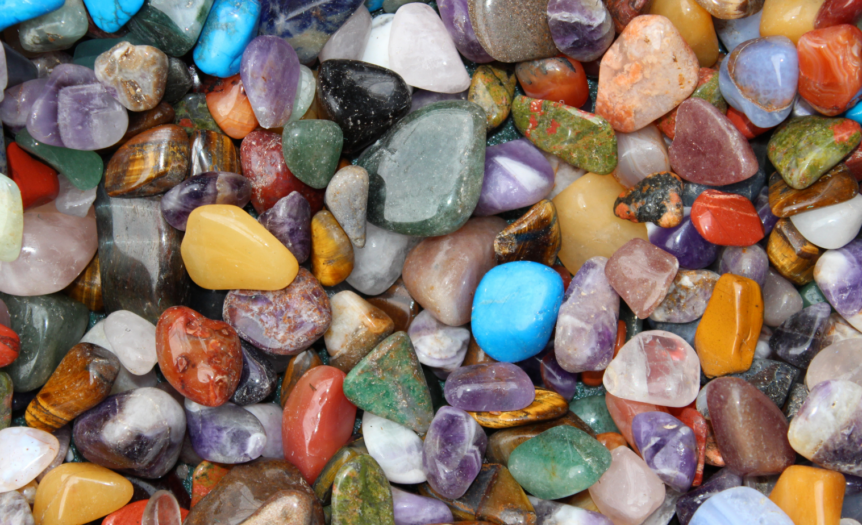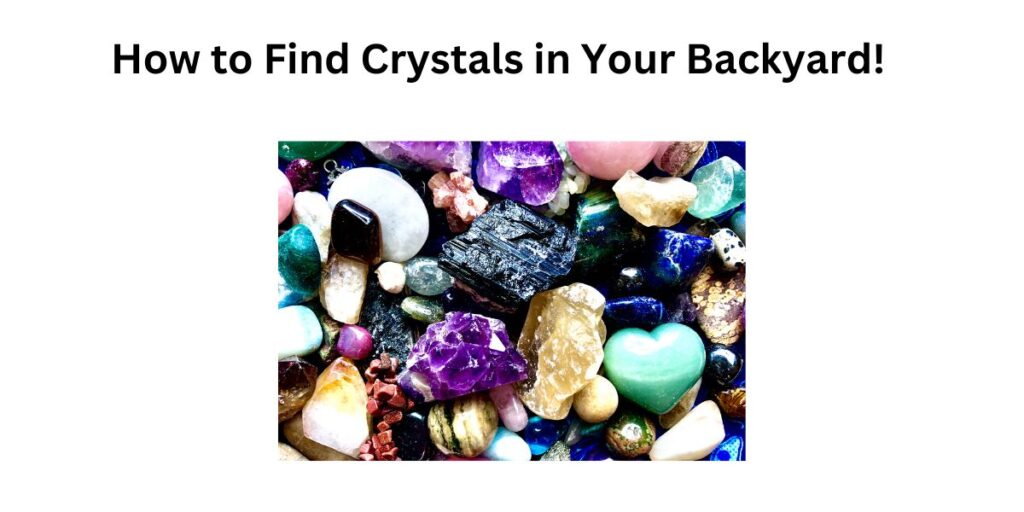You don’t need to be a geologist to embark on this exciting adventure; with the right tools and guidance, anyone can do it! In this blog post, we’ll explore how to find crystals in your own backyard while unveiling some fascinating facts about these mysterious treasures.
Supplies And Tools Needed To Find Crystals
To find crystals in your backyard, you will need supplies such as shovels for digging, a sieve for sifting through soil, gardening gloves to protect your hands, and a brush for cleaning the crystals; it’s also important to wear safety goggles.
Shovels For Crystal Digging
One essential tool for finding crystals in your backyard is a sturdy shovel suitable for crystal digging. A good-quality shovel will not only allow you to dig through layers of soil, but also help you uncover potential hidden treasures buried beneath the surface.
For instance, I’ve used my trusty hand trowel on numerous crystal-hunting adventures and have always been amazed at what can be unearthed with just a little effort! Just last month, I discovered several beautiful quartz specimens right in my own backyard using this handy piece of equipment.
Sieve
Using a sieve is an essential step in the process of finding crystals and gemstones in your backyard. This handy tool helps you separate any potential treasures from the surrounding soil, making it easier to identify and collect your findings.
To use a sieve effectively while digging for crystals, simply place some soil or gravel into the device and shake it gently.
As you become more adept at crystal hunting in your backyard, you may discover that using multiple sieves with different mesh sizes can improve your chances of success by filtering out various particle sizes.
Utilizing this method not only saves time but also allows me to focus on identifying potential crystals within the remaining contents of my sieves more efficiently.
Gardening Gloves
Wearing gardening gloves is an essential part of the crystal hunting process, as it helps protect your hands during digging and sifting through soil, rocks, and minerals.
For instance, when I first started searching for quartz crystals in my own backyard, I underestimated the importance of wearing gloves. The constant handling of rough rocks resulted in countless scratches and blisters on my hands.
After switching to a sturdy pair of gardening gloves with reinforced fingertips, not only did I prevent further injuries but also gained better grip while using tools like shovels or sieves.
Brush
I always bring a brush with me when I go crystal hunting in my backyard. This handy tool helps to remove any dirt or debris that may be covering up a potential gemstone. A soft-bristled toothbrush or makeup brush works well for this task.
It’s important to use a gentle touch, as some crystals can be fragile and easily damaged. Once cleaned, you can get a better look at the stone’s color and texture, which can help with identification.
Safety Goggles
As a crystal hunter, I always make sure to wear safety goggles when searching for gemstones in my backyard. These protective glasses shield my eyes from potential debris and dust that may be kicked up while digging or sifting through soil.
It is important to follow proper safety precautions when hunting for crystals in your backyard. Wearing safety goggles is just one way to ensure you stay safe while exploring the earth’s surface for precious minerals.
Where To Find Crystals In Your Backyard
Crystals can be found in areas with high mineral concentrations, near rocks or water sources, but it’s important to avoid power lines.
Near Rocks Or Water
I’ve found that rocks or water can be great indicators of where to find crystals in your backyard. Geologically speaking, many minerals form near rocks and bodies of water due to the way they interact with one another.
Some common areas to look for crystals include near creeks, rivers, or even on a beach.
I once discovered some beautiful amethyst crystals near a small stream that runs through my backyard. I noticed that the area around the stream had larger rocks, which turned out to contain veins of amethyst hidden inside.
Areas With High Mineral Concentrations
In my experience, areas with high mineral concentrations are the most likely places to find crystals in your backyard. These minerals can be easily identified by their unique colors and textures, and may include iron oxide, quartzite, or schist.
It’s also important to note that some areas may have higher concentrations of certain gemstones than others. For example, certain regions of California are known for their abundance of quartz crystals and amethyst geodes.
Similarly, parts of Arkansas are famous for their clear quartz crystals.
Avoiding Power Lines
It’s important to keep safety in mind when searching for crystals in your backyard. As you search, be mindful of any power lines in the area. Not only can they pose a physical hazard, but they can also interfere with metal detectors and other tools used for crystal hunting.
Power lines are usually found near roads or buildings, so it’s best to avoid those areas when looking for crystals. Instead, try searching in natural areas like trees or rocky formations away from any electrical infrastructure.
Types Of Crystals And Gemstones You May Find
Some common crystals and gemstones that you may find in your backyard include quartz, amethyst, citrine, and agate.
Quartz
Quartz is a popular gemstone that can be found in your own backyard. It is one of the most abundant minerals on the earth’s crust and comes in various colors, including white, pink, and purple.
One way to identify quartz is by its hardness. It has a score of 7 out of 10 on the Mohs scale, which means it can scratch glass.
When searching for quartz in your backyard, pay attention to areas where there are exposed rocky surfaces or gravelly soil as these are good indicators that quartz may be present.
Keep an eye out for white or clear rocks with six sides or points as these could also be signs of quartz crystals embedded within them.
Amethyst
Amethyst is a beautiful purple crystal that can sometimes be found in your backyard. It’s actually a variety of quartz, and its purple hue comes from the presence of iron in the crystal.
Amethyst is known for its calming properties and has been used for centuries to promote peaceful sleep and alleviate stress. When searching for crystals in your backyard, keep an eye out for small clusters or individual points that have a deep purple color.
You may also come across geodes that contain layers of amethyst crystals inside. Once you’ve found some amethyst, it’s important to clean it properly before displaying or using it, as dirt and debris can diminish its shine and energy.
Citrine
One of the gemstones that you may be lucky enough to find in your backyard is citrine. This beautiful yellow or orange stone is a variety of quartz and can be found near rocks or water, particularly those with high mineral concentrations.
Citrine is known for its association with abundance and prosperity, making it a popular stone for crystal healing and manifestation practices. If you do happen to find citrine in your backyard, make sure to clean it properly by soaking it in soapy water and using a soft brush to remove any dirt or debris.
Agate
Agate is another type of gemstone that you could find in your backyard. It is a variety of chalcedony and is often characterized by its banded appearance. Agates come in many different colors and patterns, with each one having unique markings that make it distinct from the others.
In general, agate can form through a process called secondary deposition where silica-rich fluids fill voids or fractures in rocks.
Cleaning And Storing Your Crystals
To keep your newly found crystals looking beautiful, it’s important to properly clean and store them. Soak them in soapy water, use a soft brush for cleaning, and store them in a cool, dry place.
Soaking In Soapy Water
To clean your backyard crystals, one method is to soak them in soapy water. Fill a bowl or container with warm water and add a few drops of dish soap or gentle cleaner. Place the crystals in the water and let them soak for 10-15 minutes.
After soaking, use a soft-bristled brush to gently scrub away any dirt or debris on the surface of the crystal.
It’s important to note that not all crystals can be soaked in water – some may be porous or contain metals that could react negatively to immersion. Always research specific cleaning instructions for each type of crystal you find in your backyard.
Using A Soft Brush To Clean
After you’ve found some crystals in your backyard, it’s important to clean them properly so they can shine bright. Using a soft brush is the safest way to clean your crystals without damaging them.
A small and soft-bristled toothbrush or paintbrush will do the trick. Gently brush away any dirt or debris, taking care not to scrub too hard as this may cause scratches on delicate surfaces.
It’s also important to rinse your crystal thoroughly with warm water after cleaning and pat it dry with a soft cloth.
Soaking your crystals in soapy water before brushing can help loosen up any stubborn grime, making it easier for you to remove it later on during the brushing process.
But remember that some fragile gemstones such as opals and pearls should not be soaked as they are porous and could absorb too much liquid causing damage over time.
Storing In A Cool, Dry Place
I always make sure to store my crystals in a cool, dry place to keep them safe and in good condition. This is important because moisture and heat can damage the crystals and cause them to lose their natural shine or even break apart.
An example of how I store mine is by keeping them in a wooden box lined with soft fabric or tissue paper. This helps prevent any scratches or chips that could happen if they were stored together without proper padding.
Remember, the way you display and store your crystals should be mindful of their natural properties so they can maintain their vibrancy for years to come.
Displaying Your Crystals
Once you’ve found your crystals, it’s time to display them! There are various ways to showcase your newfound treasures. One popular method is to place them on a windowsill where the light can catch their natural beauty.
Another option is to use a crystal grid, which involves placing specific crystals in certain patterns for various intentions such as healing or manifestation. If you have multiple smaller crystals, you could also consider putting them in a decorative bowl or jar for an aesthetically pleasing centerpiece.
I’ve always been fascinated by crystals and gemstones, but I never realized that it was possible to find them right in my own backyard. With a few supplies and some knowledge of where to look, you too can uncover these natural treasures.
When searching for crystals in your backyard, consider areas near rocks or water sources, as well as spots with high mineral concentrations.
To get started on your crystal hunt, you’ll need a few essential tools such as shovels for digging and sieves for sifting through soil. Gardening gloves and safety goggles are also important for protecting yourself during the process.
Common gemstones that can often be found in backyards include quartz, amethysts, citrine, opal and tourmaline (although less common).
Overall there is something magical about being able to find precious stones right outside our own homes.
As an avid crystal hunter, I know firsthand the importance of thorough research before embarking on any digging expeditions. While this blog outline provides a great starting point for finding crystals in your backyard, it’s essential to conduct further research to ensure you have accurate and comprehensive information.
In order to truly succeed in finding high-quality crystals and gemstones in your backyard, it’s crucial to have a solid understanding of the geology and mineralogy of your area.
This involves studying soil samples, identifying nearby geological formations, and paying attention to factors like water flow patterns that may impact where minerals accumulate.
Overall, while this blog outline serves as a helpful starting point for those interested in finding crystals in their own backyards, there is no substitute for conducting thorough research before beginning any excavation work.







